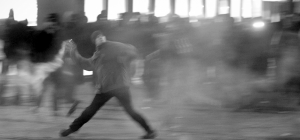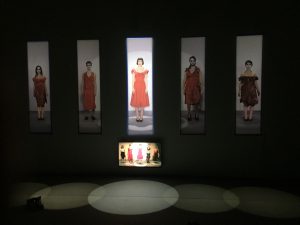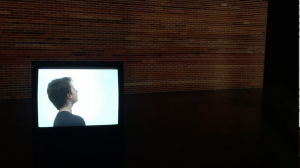The Maribor Uprisings is an interactive documentary about the protests in Maribor, Slovenia. The film was presented at Union Docs by directors Maple J. Razsa and Milton Guillen as a live participatory event wherein the whole audience participates with each other in the decision-making process of the interactive documentary.
The story itself is very simple. It’s a story of corruption in government ranging from exclusionary legislation to embezzlement countered by the people of Maribor demanding accountability. Their demands and their anger evolved into organized and guerilla protests against the Slovenian political elite. The protests spanned the sum of four months and amounted to 80 hours of footage for the directors to navigate. They explained their choice for an interactive documentary as the footage itself demanding a voyeuristic experience. They wanted to create an experience which echoed global uprisings and our insurgent generation.
 Before the film began, the directors explained the decision-making process. Throughout the story we were given checkpoints with two choices on how the story would unfold. We had to democratically and collectively decide which choice to make. The legitimacy of the democratic process can be argued since the directors still had the primary power over the process and made the executive decisions over the progression of choices. This point, however, supports the primary thesis of the film: the interactions between the audience and the directors, the roles each audience member inferentially plays, and the debates between audience members reflect the same social dynamics which take place during actual protests. One definitive choice the directors made to counter the reality of an apparent power hierarchy within protests was to give priority to femmes and people of color during discussions. The directors also explained if people feel they can easily speak up in crowds, they should give room to people who find it difficult to speak. Concurrently, people who find it difficult to speak in large crowds should challenge themselves and make choices for the audience. Once the rules were set, the directors prefaced the start of the film and said there is “no way back from the chaos.” Then the film began.
Before the film began, the directors explained the decision-making process. Throughout the story we were given checkpoints with two choices on how the story would unfold. We had to democratically and collectively decide which choice to make. The legitimacy of the democratic process can be argued since the directors still had the primary power over the process and made the executive decisions over the progression of choices. This point, however, supports the primary thesis of the film: the interactions between the audience and the directors, the roles each audience member inferentially plays, and the debates between audience members reflect the same social dynamics which take place during actual protests. One definitive choice the directors made to counter the reality of an apparent power hierarchy within protests was to give priority to femmes and people of color during discussions. The directors also explained if people feel they can easily speak up in crowds, they should give room to people who find it difficult to speak. Concurrently, people who find it difficult to speak in large crowds should challenge themselves and make choices for the audience. Once the rules were set, the directors prefaced the start of the film and said there is “no way back from the chaos.” Then the film began.
Continue reading “The Maribor Uprisings: a Live Participatory Event by Maple J. Razsa and Milton Guillen” →



 Before the film began, the directors explained the decision-making process. Throughout the story we were given checkpoints with two choices on how the story would unfold. We had to democratically and collectively decide which choice to make. The legitimacy of the democratic process can be argued since the directors still had the primary power over the process and made the executive decisions over the progression of choices. This point, however, supports the primary thesis of the film: the interactions between the audience and the directors, the roles each audience member inferentially plays, and the debates between audience members reflect the same social dynamics which take place during actual protests. One definitive choice the directors made to counter the reality of an apparent power hierarchy within protests was to give priority to femmes and people of color during discussions. The directors also explained if people feel they can easily speak up in crowds, they should give room to people who find it difficult to speak. Concurrently, people who find it difficult to speak in large crowds should challenge themselves and make choices for the audience. Once the rules were set, the directors prefaced the start of the film and said there is “no way back from the chaos.” Then the film began.
Before the film began, the directors explained the decision-making process. Throughout the story we were given checkpoints with two choices on how the story would unfold. We had to democratically and collectively decide which choice to make. The legitimacy of the democratic process can be argued since the directors still had the primary power over the process and made the executive decisions over the progression of choices. This point, however, supports the primary thesis of the film: the interactions between the audience and the directors, the roles each audience member inferentially plays, and the debates between audience members reflect the same social dynamics which take place during actual protests. One definitive choice the directors made to counter the reality of an apparent power hierarchy within protests was to give priority to femmes and people of color during discussions. The directors also explained if people feel they can easily speak up in crowds, they should give room to people who find it difficult to speak. Concurrently, people who find it difficult to speak in large crowds should challenge themselves and make choices for the audience. Once the rules were set, the directors prefaced the start of the film and said there is “no way back from the chaos.” Then the film began.